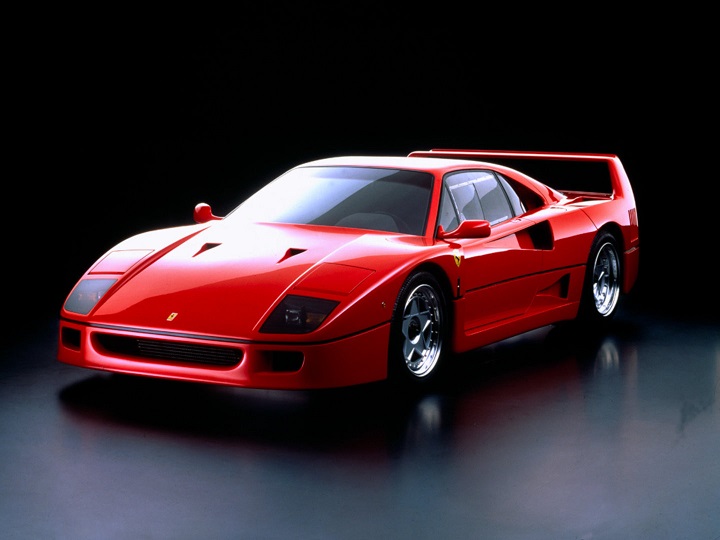

Coupe, 2 Doors, 2 Seats
10.3 l/100 km 22.84 US mpg
18.4 l/100 km 12.78 US mpg
8.6 l/100 km 27.35 US mpg
478 Hp @ 7000 rpm.
162.8 Hp/l
324 km/h 201.32 mph
2936 cm3
179.17 cu. in.
8, V-engine
Rear wheel drive,
4360 mm
171.65 in.
1970 mm
77.56 in.
1235 kg
2722.71 lbs.
| Brand | Ferrari |
|---|---|
| Model | F40 (Coupe) |
| Version | F40 |
| Engine version | 2.9 i V8 32V (478 Hp) |
| Year production start | 1987 |
| Year production end | 1992 |
| Vehicle type | Coupe |
| Horsepower RPM | 478 Hp @ 7000 rpm. |
| Acceleration 0 - 100 kmh sec | 4.1 sec |
| Curb weight kg -lbs total |
1235 kg2722.71 lbs. |
| Overall length mm - inch |
4360 mm171.65 in. |
| Doors | 2 |
| Top Speed | 324 km/h 201.32 mph |
| Designation model | F120A000 |
|---|---|
| Cam configuration | DOHC |
| Engine position and orientation | Middle, Transverse |
| Cylinders | 8 |
| Position of cylinders | V-engine |
| Displacement (liters) |
2936 cm3179.17 cu. in. |
| Eng. horsepower RPM | 478 Hp @ 7000 rpm. |
| Horsepower per litre | 162.8 Hp/l |
| Weight / horsepower kg/hp - hp/tons |
2.6 kg/Hp387 Hp/tonne |
| Weight / torque kg/Nm - Nm/tons | 2.1 kg/Nm, 467.2 Nm/tonne
2.1 kg/Nm467.2 Nm/tonne |
| Torque Nm RPM lb-ft RPM |
577 Nm @ 4000 rpm.425.57 lb.-ft. @ 4000 rpm. |
| Bore (mm in) |
82 mm3.23 in. |
| Stroke (mm in) |
69.5 mm2.74 in. |
| Compression ratio | 7.7 |
| Fuel delivery system | Multi-point indirect injection |
| Fuel type | Petrol (Gasoline) |
| Valvetrain | 4 |
| Engine aspiration | Turbocharger |
| Engine oil liters | quarts |
11 l11.62 US qt | 9.68 UK qt |
| Engine coolant |
17 l17.96 US qt | 14.96 UK qt |
| Powertrain architecture | Internal Combustion engine |
| Engine location | Middle, Transverse |
| Drive configuration | Rear wheel drive |
|---|---|
| Transmission | 5 |
| Front brakes | Ventilated discs |
|---|---|
| Rear brakes | Ventilated discs |
| Anti-lock brake system | ABS (Anti-lock braking system) |
| Front suspension | Coil spring |
|---|---|
| Rear suspension | Helical spring |
| Wheels size | 245/40 R17 |
|---|
| Passengers seats | 2 |
|---|
| Overall length mm - inch |
4360 mm171.65 in. |
|---|---|
| Overall width mm -inch |
1970 mm77.56 in. |
| Overall height mm -inch |
1125 mm44.29 in. |
| Wheelbase mm - inch |
2450 mm96.46 in. |
| Track width front mm - inch |
1595 mm62.8 in. |
| Track width rear mm - inch |
1605 mm63.19 in. |
| Curb weight kg -lbs total |
1235 kg2722.71 lbs. |
|---|---|
| Gross weight kg -lbs total |
1400 kg3086.47 lbs. |
| Capacities kg - lbs |
165 kg363.76 lbs. |
| Fuel tank liters | gallons |
120 l31.7 US gal | 26.4 UK gal |
| City l/100km - mpg |
18.4 l/100 km12.78 US mpg |
|---|---|
| Highway l/100 km - mpg |
8.6 l/100 km27.35 US mpg |
| Combined l/100 km - Mpg |
10.3 l/100 km22.84 US mpg |
| Autonomy km (combined use) | 1200 |
8 CYLINDER V-Engine
https://www.thecarspec.net/components/engine/8-cylinders-v